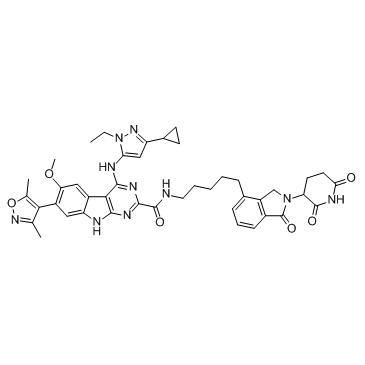BETd-260 (ZBC 260) (Synonyms: ZBC 260) |
| Catalog No.GC32791 |
BETd-260 (ZBC 260) (ZBC 260) is a PROTAC connected by ligands for Cereblon and BET, with as low as 30 pM against BRD4 protein in RS4;11 leukemia cell line. BETd-260 (ZBC 260) potently suppresses cell viability and robustly induces apoptosis in hepatocellular carcinoma (HCC) cells.
Products are for research use only. Not for human use. We do not sell to patients.

Cas No.: 2093388-62-4
Sample solution is provided at 25 µL, 10mM.
BETd-260 is a potent BET degrader based on PROTAC technology, with an IC50 of 30 pM against BRD4 protein in RS4;11 leukemia cell line.
BETd-260 is a potent BET degrader based on PROTAC technology, with an IC50 of 30 pM for BRD4 protein in RS4;11 leukemia cell line. BETd-260 (ZBC260; Compound 23) shows inhibitory activity against the growth of RS4;11 leukemia cells and MOLM-13 cells with IC50s of 51 pM and 2.2 nM, respectively, and induces apoptosis in both RS4;11 and MOLM-13 cell lines at 3-10 nM[1].
BETd-260 (5 mg/kg, i.v., every other day, thrice a week for 3 weeks) causes rapid tumor regression with a maximum of >90% regression in mice bearing RS4;11 xenograft tumors, and with no body weight loss or other signs of toxicity in mice. BETd-260 (5 mg/kg, i.v.) degrades the BRD2, BRD3, and BRD4 proteins for more than 24 h, with robust cleavage of PARP and caspase-3, and strong down-regulation of c-Myc protein in RS4;11 xenograft mice model[1].
[1]. Zhou B, et al. Discovery of a Small-Molecule Degrader of Bromodomain and Extra-Terminal (BET) Proteins with Picomolar Cellular Potencies and Capable of Achieving Tumor Regression. J Med Chem. 2018 Jan 25;61(2):462-481.
Average Rating: 5 (Based on Reviews and 11 reference(s) in Google Scholar.)
GLPBIO products are for RESEARCH USE ONLY. Please make sure your review or question is research based.
Required fields are marked with *




















